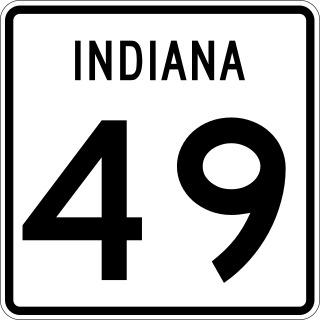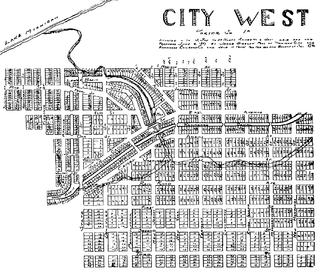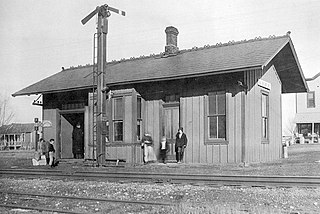
Porter County is a county in the U.S. state of Indiana. As of 2020, the population was 173,215, making it the 10th most populous county in Indiana. The county seat is Valparaiso. The county is part of Northwest Indiana, as well as the Chicago metropolitan area. Porter County is the site of much of the Indiana Dunes, an area of ecological significance. The Hour Glass Museum in Ogden Dunes documents the region's ecological significance.

Watseka or Watchekee was a Potawatomi Native American woman, born in Illinois, and named for the heroine of a Potawatomi legend. Her uncle was Tamin, the chief of the Kankakee Potawatomi Indians.
The Calumet Region is the geographic area drained by the Grand Calumet River and the Little Calumet River of northeastern Illinois and northwestern Indiana in the United States. It is part of the Great Lakes Basin, which eventually reaches the Atlantic Ocean. It is a sub-region of the greater Northwest Indiana region and the even larger Great Lakes region.

State Road 49 (SR 49) is a 44.15-mile (71.05 km), north–south state highway in the northwestern part of the U.S. state of Indiana. Its northern terminus is at an intersection with U.S. Route 12 in Porter near the entrance to Indiana Dunes State Park. The southern terminus is a rural intersection with State Road 14 in Barkley Township at Lewiston, 10 miles (16 km) northeast of Rensselaer.
Joseph Bailly was a fur trader and a member of an important French Canadian family that included his uncle, Charles-François Bailly de Messein.

The Potawatomi Trail of Death was the forced removal by militia in 1838 of about 859 members of the Potawatomi nation from Indiana to reservation lands in what is now eastern Kansas.

Westchester Township is one of twelve townships in Porter County, Indiana. It is included in the Calumet, Northwest Indiana, and Great Lakes regions. It is located on the southern shore of Lake Michigan, about 50 miles (80 km) southeast of Chicago. It stretches from the famous Indiana Dunes on its northern border, south to the Valparaiso Moraine, a ridge of rolling hills left by the last glacier to pass through the area. As of the 2010 census, its population was 19,396.
The Indiana Dunes are natural sand dunes occurring at the southern end of Lake Michigan in the American State of Indiana. They are known for their ecological significance. Many conservationists have played a role in preserving parts of the Indiana Dunes. The Hour Glass, a museum in Ogden Dunes, showcases some of the ecological import of the Dunes.
Tetinchoua was a Miami chief who had lived during the 17th century. Nicolas Perrot, a French traveler, met him in Chicago in 1671. He characterizes Tetinchoua as being "the most powerful of Indian chiefs". Perrot stated that the Miami chief could easily manage approximately five thousand warriors as evidence of his authority and power. He never lacked guarded protection of at least forty men who were even posted around Tetinchoua's tent while he slept. Although he was a leader who hardly had personable interface with his people, he was successful in his ability to communicate through subordinates who would relay orders. Despite his highly regarded warrior reputation, he was also described as being attractive and bearing a softness to his features and mannerisms according to Father Claude Dablon.

Salt Creek is a 24.0-mile-long (38.6 km) tributary of the East Arm Little Calumet River that begins south of Valparaiso in Porter County, Indiana and flows north until it joins the East Arm Little Calumet River just before it exits to Lake Michigan via the Port of Indiana-Burns Waterway.

City West was a village in Porter County, Indiana, US, located on the shore of Lake Michigan approximately 10 miles west of Michigan City, Indiana. It was situated near the mouth of Fort Creek, now known as Dunes Creek, which empties into Lake Michigan near the Indiana Dunes State Park swimming beach. It was located near the former site of Petit Fort.
Charles F. Lembke was an American architect and contractor who was prominent in Valparaiso, Indiana. Lembke built many downtown Valparaiso-area buildings, such as the Memorial Opera House, Carnegie public Library, Hotel Lembke, and several local schools.

Michael Jerome Aylesworth is an American politician who is a current member of the Indiana House of Representatives. A member of the Republican Party, Aylesworth was elected to the Indiana House on November 4, 2014 and was subsequently sworn in on November 19 of that year. Elected to represent the 11th district, Aylesworth's district represents southern Lake and Porter County.

Hurlburt is an unincorporated community in Porter Township, Porter County, in the U.S. state of Indiana.
Coburg was an unincorporated town in Washington Township, Porter County, in the U.S. state of Indiana.
The Lake-Porter County Conference was an IHSAA-sanctioned conference in Northwest Indiana. The conference formed by 1929 at latest, consisting of smaller schools in Lake and Porter counties. The much smaller rural Porter County schools split off in 1933, though Portage and Wheeler would compete in both the LPCC and Porter County Conference. The conference ended in 1949, as almost every school would form the Calumet Athletic Conference.
The Kankakee Valley Conference, occasionally known as the Kankakee Valley Athletic Association, was an IHSAA-sanctioned conference in northwestern Indiana that lasted from 1933 until 1967. The conference formed as a merger of the Jasper and Newton county conferences, along with schools from the newly formed Porter County Conference wanting another league to compete in. The league would also add schools from Starke and White counties soon after forming. Other than adding LaCrosse from LaPorte County for a short time, the league did not stray from this footprint. The league was always closely tied with the Midwest Athletic Conference, with some schools playing in both conferences in the MAC's first incarnation, and many KVC schools either helped form the MAC's lineup in its reformation, or ended up moving to the league after the collapse of the KVC.

Tremont was a flag stop on the South Shore Line located at Tremont Road in Porter County, Indiana. The station was built by the Chicago, Lake Shore and South Bend Railway and opened circa 1908, serving its namesake town and later the Indiana Dunes.













